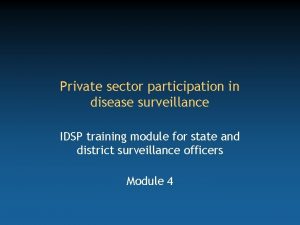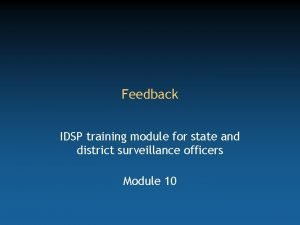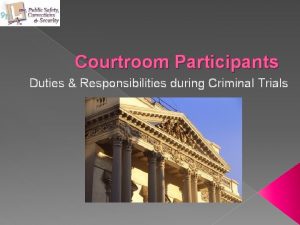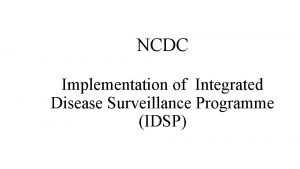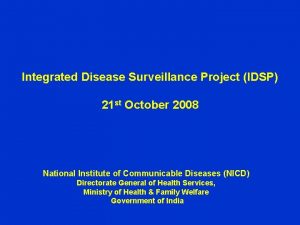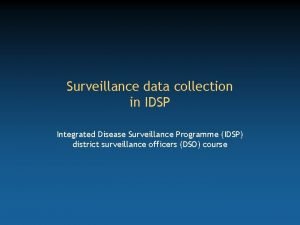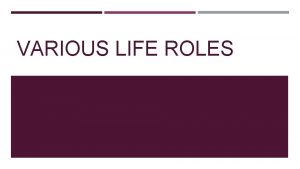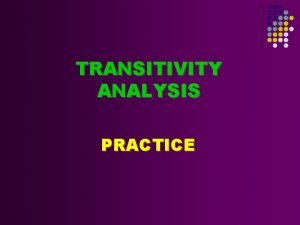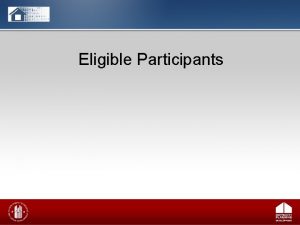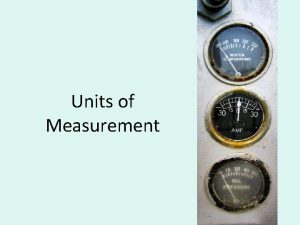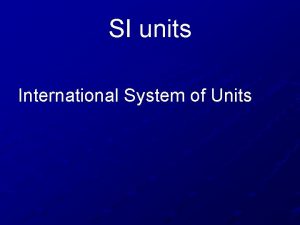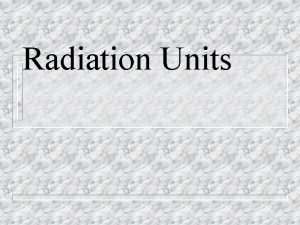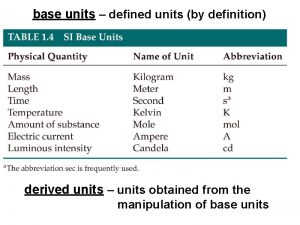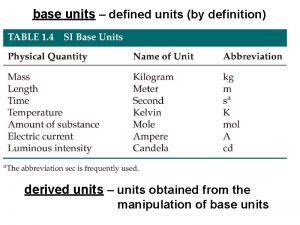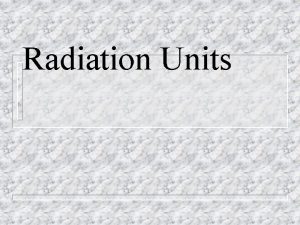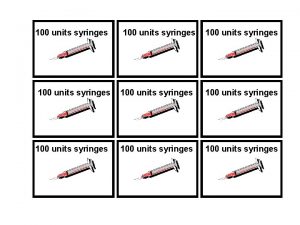Reporting units participants and their roles IDSP training




















- Slides: 20

Reporting units, participants and their roles IDSP training module for state and district surveillance officers Module 3

Learning objectives • List the reporting units involved in surveillance in Integrated Disease Surveillance Project in your district: In public and private sectors; rural and urban areas • List the key functionaries in reporting units responsible for surveillance related activities and describe their roles • Fill the specific reporting formats without error from various reporting units • Draw a flow diagram of the process and dynamics of timely flow of information

Surveillance: A systematic, ongoing process • • • Data collection Transmission Analysis Feedback Action

Reporting unit • Nature § Health facility / individual in private/ public sector § Located in rural or urban area • Function § Collects information of health conditions identified in specified formats § Transmits these in pre-specified timely manner to the next higher level

Reporting units for disease surveillance Public sector (Exhaustive) Private (Sentinel) Rural • Community health centres • District hospitals • Practitioners • Hospitals Urban • Urban hospitals • ESI • Railways • Medical colleges • Nursing homes • Hospitals • Medical colleges • Laboratories

Other sentinel reporting sites 1. Antenatal clinic § HIV, HBV, HCV 2. Water board 3. Pollution control board 4. District police § Road traffic injuries

Active and passive reporting • Active reporting § Health workers • House visits • Passive reporting § All other reporting units

Three levels of case definitions for three levels of actors Level Actor of the surveillance system • Syndromic (Form “S”) • Health workers • Presumptive (Form “P”, probable) • Medical officers * • Confirmed • Laboratories * Except for malaria and tuberculosis

Reportable diseases for multi-purpose health workers and health assistants • • • Diarrhea Jaundice Fever Cough Acute flaccid paralysis Unusual events (Death, hospitalization)

Reportable diseases for medical officers • Diarrhea • Jaundice • Fever § § § Malaria Typhoid Japanese encephalitis Dengue Measles • Cough § Tuberculosis • Acute flaccid paralysis • Unusual events (Death, hospitalization)

Zero reporting • Do not mix up: § Zero § Missing information • Zero reporting is important to confirm that the condition was looked for and not found

Unusual clustering of cases OR health event causing death in a short span of time • Report immediately § § § Telephone Fax Email Special messenger Police wireless • Follow with written report

Quality check before reporting 1. Filling of forms by health care workers 2. Review by senior staff 3. Transmission to the higher level § Copy kept in the facility

Person responsible for data compilation and transmission Levels Person responsible • Primary health centres • Pharmacists • Community health centres • Computer / pharmacists • Sentinel private providers • Medical officers • District hospitals • Computer / pharmacists • Medical colleges • Statistical officer • Laboratories • Medical officer / technician

Time sequence Day of the week Event Monday • Primary health centre reports to community health centre Tuesday • Community health centre reports to district

Statistical assistant at the district level • • Receives data from reporting units Enters data into computer Checks data validity Generates reports Submits report to surveillance officer Prepares a report summarizing the analysis Submits report to state surveillance officer

Case Feedback Reporting unit Immediately Lab slip Outpatient register Inpatient slip Weekly Lab register +ve slides + sample -ves Form L Common reporting form P Weekly Inpatient register Weekly District public health laboratory Computer (District) District surveillance officer

Points to remember (1/3) • A reporting unit is a health facility / individual collecting the information and transmitting it to the next higher level • Reporting health facilities will be from both rural and urban settings in public and private sectors • All public health facilities in rural and urban areas will report • Only sentinel sites will report in the private sector

Points to remember (2/3) • Other sites from where sentinel surveillance data will be used will consist of ANC Sites NACO, the water board, the pollution control board and the police (Road traffic accidents) • All reporting centres are required to provide zero reporting • All medical officers will report presumptive diagnosis in the absence of confirmation by the laboratory

Points to remember (3/3) • There will be no linking of clinical and laboratory diagnoses • Any unusual clustering of cases or any health event causing death must be reported immediately § Verbal reports must be followed by a written report • All reporting units are required to send the regular surveillance data in pre-specified formats every week to the district surveillance unit
 Idsp training
Idsp training Idsp training module
Idsp training module Non professional courtroom participants
Non professional courtroom participants Idsp ihip
Idsp ihip Www.idsp.nic.in data entry
Www.idsp.nic.in data entry Optiview usa
Optiview usa Idsp data entry
Idsp data entry Introduction of the participants
Introduction of the participants Statuses and their related roles determine
Statuses and their related roles determine Life roles experience examples
Life roles experience examples Statuses and their related roles determine
Statuses and their related roles determine Botox brow lift technique
Botox brow lift technique Variable costing income statement
Variable costing income statement Base and derived quantities
Base and derived quantities Ssenser
Ssenser Poison gas in ww1
Poison gas in ww1 Basketball ladder tournament
Basketball ladder tournament Teachertech.rice.edu
Teachertech.rice.edu Partial counterbalancing psychology
Partial counterbalancing psychology Money market participants
Money market participants Space shuttle discovery
Space shuttle discovery
